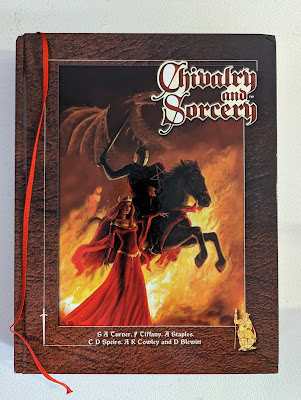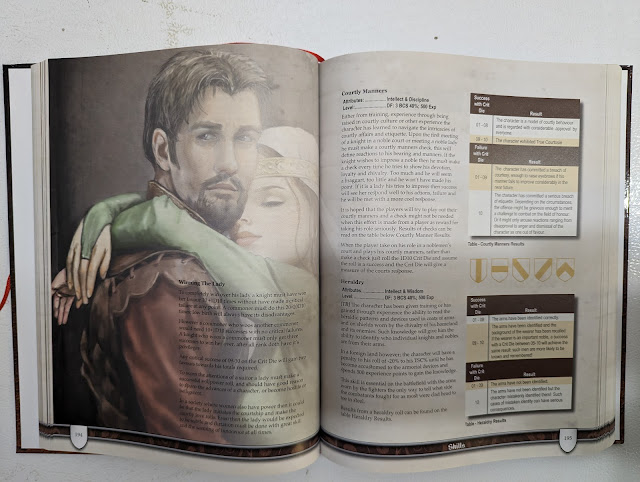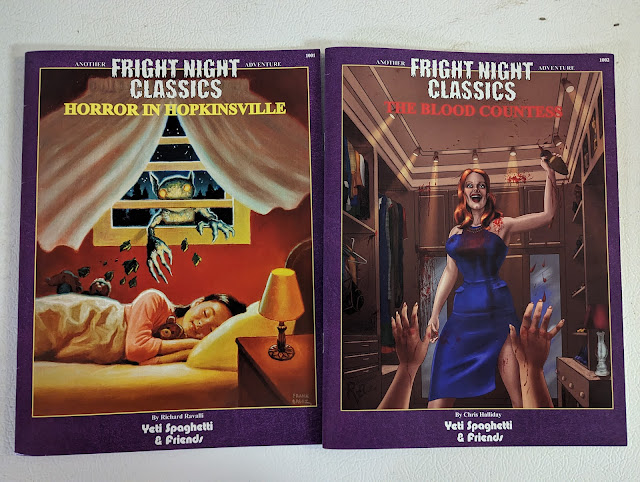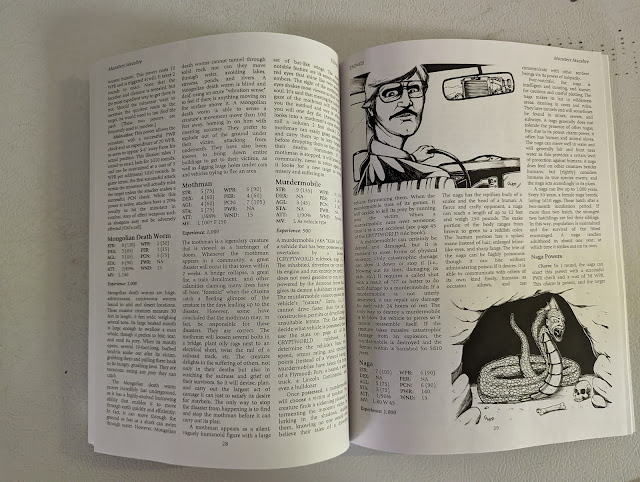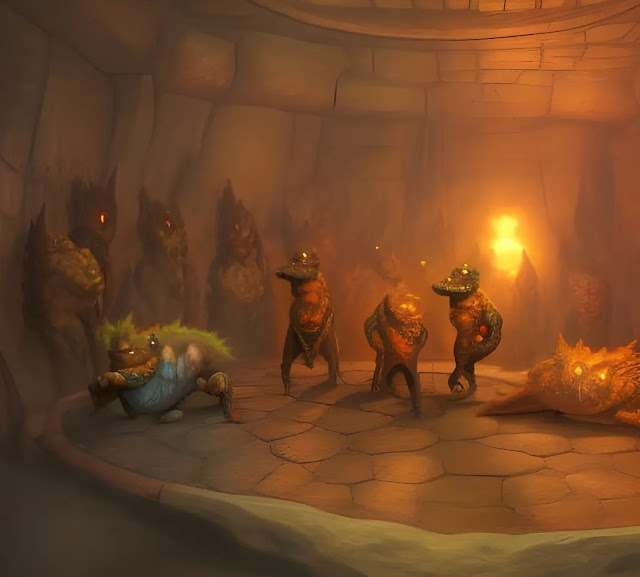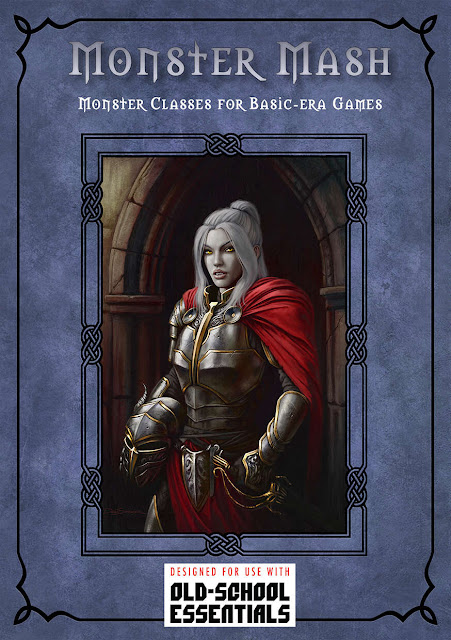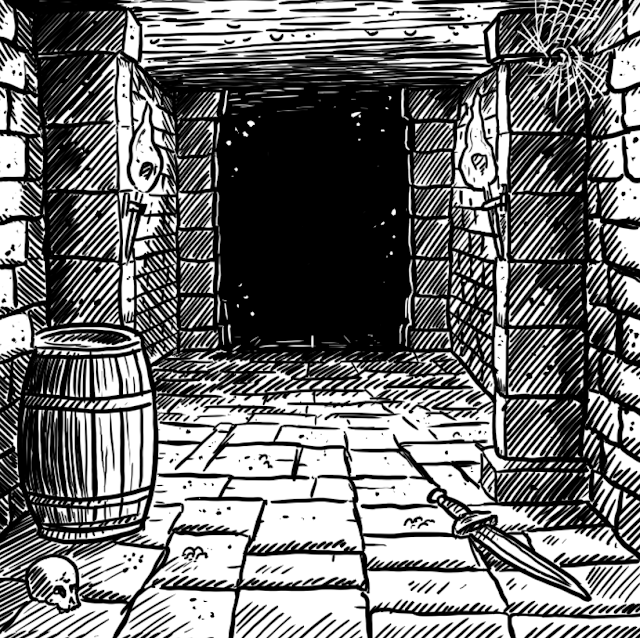The Other OSR—Gozr – Sci-Fantasy RPG
 The Angry Sun bleeds on the Broken World. Some days it burns hot and cold. Some days it burns the land. Some days it drains the Wiz of their powers. Others it is cool and sleepy. Sky Wyrms hunt for meat below. Fallen towers radiate magic and hide spells. Ruins hide the secrets and treasures of the past. This is the Broken World. The Broken World is the world of the Gooz now. Warty, hairy, dirty, ugly, flute-eared Gooz. Once they were just vermin, but the Pretty Ones are long dead in the ground. The Gooz explore the world, search the ruins, and climb the towers, sometimes to save the Broken World, but mostly to get rich. They set out from Gooz City ready to face danger such as the Quetzplow, which will slurp out a Gooz’s brains, Assassin Bots, and coin-eating Mooku which can glue a Gooz to the ground with its snot. This is the setting for the Gozr – Sci-Fantasy RPG, a post-apocalyptic roleplaying game designed and drawn by James V. West. The author and illustrator is best known for the fanzine, Black Pudding, the Old School Renaissance, Swords & Sorcery fanzine, which he also draws and writes—just like the Gozr – Sci-Fantasy RPG. Black Pudding brought a slightly gonzo sensibility to the Old School Renaissance and every issue left the reader wanting to see a roleplaying based on its content. That roleplaying game is Doomslakers. It not the Gozr – Sci-Fantasy RPG, which instead is an over-the-top, gonzo, underground comic style post-apocalyptic roleplaying game in which everything is hand drawn and handwritten. Literally nothing in the Gozr – Sci-Fantasy RPG is printed using traditional founts or layout. Coloured in vibrant shades, it is a riotous mass of tables, rules, and illustrations that boggles the mind!
The Angry Sun bleeds on the Broken World. Some days it burns hot and cold. Some days it burns the land. Some days it drains the Wiz of their powers. Others it is cool and sleepy. Sky Wyrms hunt for meat below. Fallen towers radiate magic and hide spells. Ruins hide the secrets and treasures of the past. This is the Broken World. The Broken World is the world of the Gooz now. Warty, hairy, dirty, ugly, flute-eared Gooz. Once they were just vermin, but the Pretty Ones are long dead in the ground. The Gooz explore the world, search the ruins, and climb the towers, sometimes to save the Broken World, but mostly to get rich. They set out from Gooz City ready to face danger such as the Quetzplow, which will slurp out a Gooz’s brains, Assassin Bots, and coin-eating Mooku which can glue a Gooz to the ground with its snot. This is the setting for the Gozr – Sci-Fantasy RPG, a post-apocalyptic roleplaying game designed and drawn by James V. West. The author and illustrator is best known for the fanzine, Black Pudding, the Old School Renaissance, Swords & Sorcery fanzine, which he also draws and writes—just like the Gozr – Sci-Fantasy RPG. Black Pudding brought a slightly gonzo sensibility to the Old School Renaissance and every issue left the reader wanting to see a roleplaying based on its content. That roleplaying game is Doomslakers. It not the Gozr – Sci-Fantasy RPG, which instead is an over-the-top, gonzo, underground comic style post-apocalyptic roleplaying game in which everything is hand drawn and handwritten. Literally nothing in the Gozr – Sci-Fantasy RPG is printed using traditional founts or layout. Coloured in vibrant shades, it is a riotous mass of tables, rules, and illustrations that boggles the mind!Gozr – Sci-Fantasy RPG is published by Random Order Creations following a successful Kickstarter campaign. It has an Old School Renaissance sensibility, one it shares with microclones such as Into the Odd, Knave, and Cairn, and in comparison with those roleplaying games and other retroclones, it has two primary issues—one obvious, one less so. The former is the presentation. It is bold, it is bright, it is a jumble, and that makes it inaccessible—or at least difficult to access with any ease. Everything jumps off the page, so it takes just that little more effort than another roleplaying game would. The latter is the lack of a ready to play scenario. Gozr – Sci-Fantasy RPG does include a table of ‘Recent Events of Some Gravity’, an ‘Adventure Machine’ table, and a ‘Towers’ table to help the Gooz Master create adventures from these prompts, but a scenario would have been a useful inclusion.
A Gooz in Gozr – Sci-Fantasy RPG starts with three attributes or Action Classes as they are called here—Cunning, Magic, and Prowess. Confusingly, they are abbreviated to ‘AC’, which sort of makes sense when the Gooz Master asks a player to roll against an ‘Action Class’. These are initially rated eight, ten, or fourteen, the lower the Action Class the better it is. He also has Hit Points; a Defence value, which reduces damage taken directly; and points of ‘Gooz’ to spend on doing extraordinary things. Creating a Gooz is a fourteen-point step, as a player rolls not just for starting Hit Points and armour, but also starting weapon, money, colour of blood, colour of skin, eyes, and hair, hair style, lucky symbol, talent, background, clothes, name, possessions, and ears. Talents include Alchemy, Psionic, Strong, Eyebeam, and more. Alternatively, many of these a player can simply pick from the table. A Gooz is just a Gooz unless he is a Gooz Wizard and even if not, there is a chance of his knowing a single vulgar spell or possibly more (if he knows more, he might as well be a wizard).
Name: Finus
Cunning: 8
Magic: 10
Prowess: 14
Hit Points 15
Gooz 5
Talent: Extra Arm
Armour: None
Weapons: Falx (2d4), Pistol (2d4 six-shot)
Lucky Symbol: Cat
Money: 3 Tossers
Blood: Orange
Skin: Pink Hair: None Hair Colour: Grey Eyes: Pink Ears: Triangles
Wearing: Crude loincloth
Possessions: Pyramid puzzle, lockpick kit, blanket
Background: Burglar
Need: Set up the best cat sanctuary in all of Gooz City
Deed: Stopped Kern from eating another cat
Mechanically, Gozr – Sci-Fantasy RPG is simple. It is player-facing, so a player rolls the dice both to attack and defend in combat, rather than the Gooz Master rolling for the latter. To have his Gooz undertake an action, a player rolls against the appropriate Action Class, aiming to roll equal to or higher than the value. Thus, lower Action Classes are better than higher ones. A natural twenty is a critical hit and a special effect will always apply, such as a knockdown or a disarm, whereas it may apply if the roll is a ‘Solid Hit’, five or more higher than the value of the Action Class and . A natural roll of one is a fumble, in which case the player describes the unfortunate outcome. However, a roll of just one under the Action Class is called a ‘Graze’ and while counted as a miss or failure, allows for a small benefit. A Gooz can be Lucky or Unlucky, in which case a +2 or -2 is levied on the roll, respectively. It is also possible for a Gooz to be luckier or unluckier than this. One nice touch about the Gooz Sheet for Gozr – Sci-Fantasy RPG is that space is given for both ‘Solid Hit’ and ‘Graze’ values for each Action Class.
Gooz can also be spent for the Gooz to be amazing. A point allows a Gooz to pull off a cool stunt, steal the initiative, succeed at die roll, learn a fact from the Gooz Master, gain an extra action, and even add a fact to current game. Gooz is the equivalent of hero or luck points and refreshes daily.
Combat in Gozr – Sci-Fantasy RPG is similarly simple, but can also be deadly. On a turn, a Gooz can do one thing—take an action or move, plus do something trivial. The Defence value is deducted from any damage rolled, but all damage dice explode, so can inflict a lot of damage and easily kill a Gooz. If an enemy’s Hit Points are reduced to zero, then it is dead, but a Gooz has a choice—death or debasement. The former is the noble choice and the player’s new Gooz gains a small boon. The latter means that the Gooz is knocked down, scarred, and suffers from the permanent effect of the deadly blow. Damage can also be ‘Real’ such as that suffered by a Wizard from his weakness. This ignores Defence. Beyond this, Gozr – Sci-Fantasy RPG covers rules for fumbles, cover, conditions, morale, poisons, nasty scars, travel, exploration, and more.
Magic in Gozr – Sci-Fantasy RPG is divided between the Vulgar, the Wizardly, and the True. . Vulgar magic includes spells such as Bite It or Sparkler or Hold Breath. Whilst magic requires a roll against a Gooz’s Magic Action Class, a Wizard can undo, counter, and even reverse the effects of Vulgar spells. True magic is not to be trifled with and all Gooz believe that doing so was what killed the Pretty Ones and really, really annoyed the Sun. An actual Wizard must adhere to the three Laws of True Magic—bear a Wizard’s mark, suffer a weakness that is his bane, and be followed by a Watcher who will always be following and judging the Wizard’s exploits. Wizard spells are more powerful than Vulgar spells and include spells such as Blend In, Exploding Doom, Ice Burst, and Liar. All cost Wiz to cast and a Wizard begins play with between two and twelve points of Wiz. Points of Wiz are recovered much like Hit Points, but the Wizard must choose between the two—he cannot recover both at the same time. A Wizard can also have a familiar and know a few tricks. One major difference between ordinary Gooz and Gooz Wizards, at least mechanically, is that ordinary Gooz begin with the equivalent of having gained a Level prior to beginning play. Gooz gain Levels by surviving adventures and with a new Level gain two out of more Hit Points, a spell, increased Wiz, a treasure, or some lucky rolls.
Treasure is where Gozr – Sci-Fantasy RPG begins show off the weirdness of its setting. Items of power can sacrificed in return for fortune. At worst, this result in scorched earth as the Sun rains down fireballs on the land and everyone knows about it, but at best, not only all the Gooz go up a Level, but the land is healed for a time… Quite what that means is left up to the Gooz Master to decode. There are long tables of treasure, including Frivolous Junk, Strange Items, Odd Armour, and Super Tech. The Gooz Master can even give any treasure secret properties with another table. In terms of setting, Goozer City, the last beacon of civilisation, first bastion of Gooz ascendancy, is detailed in terms of more tables that the Gooz Master can roll on to create streets, buildings, routes, smells, vendors, and more. Beyond the city there is map of the immediate regions with short encounter tables for each, an ‘Adventure Machine’ table and tables to create towers that leak sorcery and secrets, the daily effects of the Sun, and both a table to create monsters and a decent bestiary too.
Physically, Gozr – Sci-Fantasy RPG is cartoonishly presented, in a style that echoes Ralph Bakshi’s Wizards. It is busy, vibrant, and full of little embellishments that seem to sneak into view as you are trying to find something else. It is not so much well written as well hand drawn and written giving it a highly distinctive look. However, it could be better organised as the section on Wizards and magic is the middle of the section that ready should be for the Gooz Master.
There can be no doubt that the Gozr – Sci-Fantasy RPG is as much a piece of art—cartoonish art—but art nonetheless, as it is a roleplaying game. As a work of art it is more accessible than as a roleplaying game, its funky, gonzo fanzine-like style often inhibiting the technical nature of the roleplaying game. Not necessarily to the point where the Gozr – Sci-Fantasy RPG is unplayable, but rather to present the reader with a hurdle that has to be overcome in finding where everything is and thus learning how to play. The other hurdle is the lack of scenario. Now there are plenty of tables which the Gooz Master can take inspiration from, but given that Gozr – Sci-Fantasy RPG includes a handful sample Player Characters, it seems odd not to have a starter scenario too.
Gozr – Sci-Fantasy RPG looks—and is—fun. Weird and wacky, funky and freaky, gonzo and goofy, Gozr – Sci-Fantasy RPG is a joyously higgledy-piggledy toolkit for cartoonishly post-apocalyptic fun.

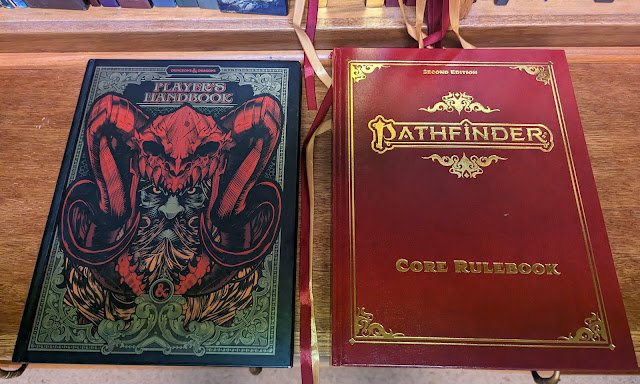

 Requirements Your last action was to Raise a Shield. You adopt a wide stance, ready to defend both yourself and your chosen ward. Select one adjacent creature. As long as your shield is raised and the creature remains adjacent to you, the creature gains a +1 circumstance bonus to their AC, or a +2 circumstance bonus if the shield you raised was a tower shield.
Requirements Your last action was to Raise a Shield. You adopt a wide stance, ready to defend both yourself and your chosen ward. Select one adjacent creature. As long as your shield is raised and the creature remains adjacent to you, the creature gains a +1 circumstance bonus to their AC, or a +2 circumstance bonus if the shield you raised was a tower shield. Range 60 feet; Targets your familiar You draw upon your patron's power to momentarily shift your familiar from its solid, physical form into an ephemeral version of itself shaped of mist. Your familiar gains resistance 5 to all damage and is immune to precision damage. These apply only against the triggering damage. Heightened (+1) Increase the resistance by 2.
Range 60 feet; Targets your familiar You draw upon your patron's power to momentarily shift your familiar from its solid, physical form into an ephemeral version of itself shaped of mist. Your familiar gains resistance 5 to all damage and is immune to precision damage. These apply only against the triggering damage. Heightened (+1) Increase the resistance by 2.

